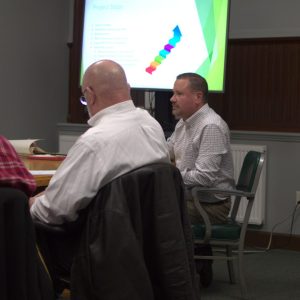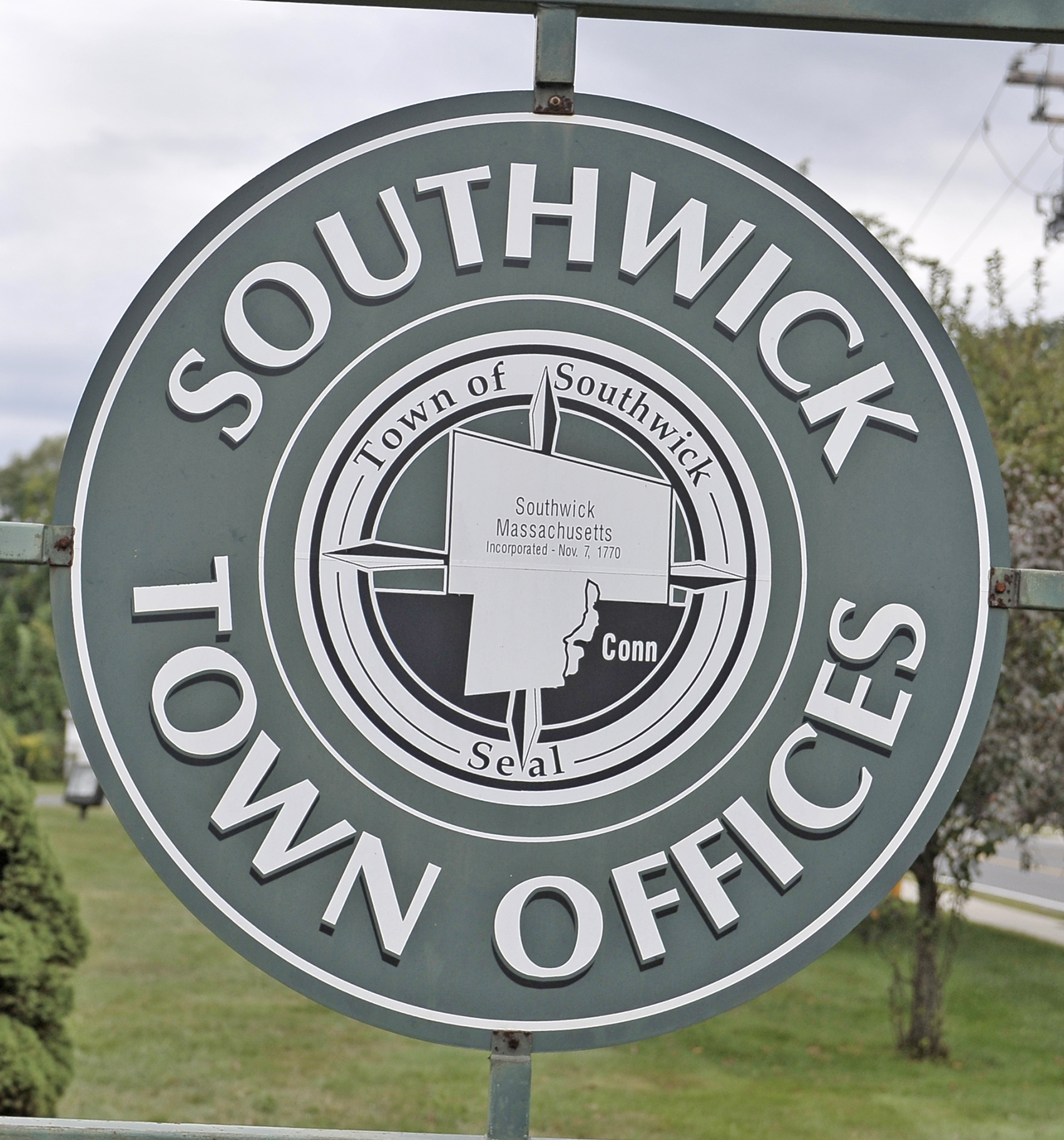WESTFIELD – The Zoning Board of Appeals conducted two public hearings last night on petitions submitted by applicants seeking relief from zoning requirements.
The two petitions were dramatically different, but both were opposed by neighboring residents. One appeal sought relief from the side-yard setback requirement for shed at a Colony Drive residence, while the other was relief needed for a major condominium rehabilitation and construction project off Jefferson Street.
Edward J. Osowski III of 17 Colony Drive is seeking a dimensional special permit to locate a 240 square foot shed not less than 3 feet from his side property line.
Osowski purchased the prefabricated shed after a tree fell on his existing shed.
“I didn’t know I needed a building permit to put the shed on my property,” Osowski said during the ZBA hearing. “The former shed was crushed by a tree. The new shed is the same distance from the property line, but on the opposite side of the yard. I did not want to put it in the same location surrounded by trees (in a neighboring wood lot), I didn’t want to lose another shed.”
Osowski said that the damaged shed is still on his property.
“There is still stuff in it, but it will be removed when this issue is resolved,” he said. “I haven’t put anything in the new shed yet.”
ZBA Chairman Michael Parent said removal of the existing structure will be part of any decision rendered by the board.
Paul A. Charette of 7 Colony Drive, whose property abuts the side of Osowski property where the new shed was placed. Charette raised several objections to the petition to put the shed next to his property.
“I am familiar with city ordinance. A shed that size has to be on a foundation and taxed as a garage,” Charette said.
City ordinance permits sheds up to 150 square feet. Osowski’s structure is 240 square feet and is supported on blocks.
“I’m concerned about the location. It’s very close to my property line. I’m not in favor of this at all,” he Charette said. “I know he likes to work on cars and projects, but I want to be able to enjoy my property without listening to power tools. My wife and I are concerned we will not be able to utilize our property.”
Osowski said the shed does not have electrical power and that it will be used for storage of garden and lawn equipment and furniture.
The ZBA closed the hearing and will visit the site before making a decision of its Feb. 1 meeting.
The second hearing pertained to a frontage waiver needed to convert an abandoned machine shop between Jefferson and Franklin streets and construction of a new building for a proposed nine-unit condo project.
The property has been abandoned for decades and has become a blight to the neighborhood, requiring frequent police intervention to prevent its sues for consumption of drugs and alcohol.
The property was acquired last year by the Shah Property Corp. of 37 Hatfield St., Northampton, which has petitioned the board for a variance from the frontage requirement to allow the project to move forward. City ordinance requires frontage of 100 feet, but the property has only 65 feet along Jefferson St. and 10 feet along Franklin Street.
The City Council voted to rezone the property for Residential C use, which allows multifamily units.
The proponents plan to demolish one building, rehabilitate a second building into four condominium units and construct a new building housing another five units.
Parent, speaking at the beginning of the hearing, warned the petitioners, represented by Attorney Raymond W. Zenkert Jr. and Marc Shute of D.L. Bean, Inc., that the requirements of a variance are rigorous.
“You have to meet four criterion,” Parent said. “We will not give a variance unless all four criterion are met.”
One of those conditions is that the variance will not result in “detriment to the public good,” while the others relate to conditions of the property or building such as shape, size, topographical detail and soil conditions. Another criterion is proof that there is a “substantial hardship, financial, or otherwise owing to the unique circumstances” and that there will be “no derogation from the intent or purpose of the bylaw or ordinance.”
Zenkert presented case-law supporting his argument that the variance petition meets those criterion. Court decisions, which would allow issuance of the variance, related to “unusual existing buildings which are sound structures, but not well suited to the current conforming use.”
Zenkert said that the factory was used for decades, but because that use was abandoned, the building cannot be used for that purpose under the current zoning restrictions.
“This area is a blight,” Zenkert said. “It’s an area where there is evidence of heavy drug and alcohol use.”
“The hardship is that without the benefit of frontage, there is no practical use of the property,” he said. “This (condo project) will not change the residential character of the neighborhood. It will, in fact enhance it, blend in and make the neighborhood a safer place.”
Issuance of the variance “can be justified in the unique character of this building as shown in the case-law presented tonight,” Zenkert said.
A number of residents spoke in opposition to the variance, raising issues related to the impact of the project. The residents did not generally opposed the condo project because it would remove the blight now there – just the scope of that project.
Residents expressed concern that a nine-unit project would add to the already congested traffic pattern which would pose a safety risk to young children, that it will further exasperate the limited parking situation.
David L. Thatcher of 35 Jefferson St., said he is not opposed to a reuse of that blighted property.
“While the concept is fine, the scope of the project is way out of line,” he said. “Nine units in that space will overwhelm the neighborhood. I could live for four or five units.”
Gary Wellspeak of 48 Jefferson St., also addressed that concern.
“The property is an eyesore, but none units is too much for that area,” Wellspeak said. “I can’t say enough against that many units. When it was a factory, everybody went home at 5 P.m. and did not come back until 7 a.m. the following day, but with nine units is will be noisy all of the time.”
Michael and Wendy Creech of 95 Franklin St., stated that their concern is that the five units to be constructed will be right next to their property.
“Those five units will be along the side of my back yard,” Wendy said. “There will be a lot of people in that tiny space. What kind of barriers will there be to protect my privacy, will I have a dumpster in my back yard?”
Parent said most of those concerns raised by residents last night will be addressed by the Planning Board when the project is presented for a site plan review, but that the ZBA’s area of responsibility is defined by state law and limited to the specific requirements of variance review.
Dan Moriarty can be reached at [email protected]
Massachusetts General Law, Chapter 40-A, Section 10. (Variances) The permit granting authority shall have the power after public hearing for which notice has been given by publication and posting as provided in section eleven and by mailing to all parties in interest to grant upon appeal or upon petition with respect to particular land or structures a variance from the terms of the applicable zoning ordinance or by-law where such permit granting authority specifically finds that owing to circumstances relating to the soil conditions, shape, or topography of such land or structures and especially affecting such land or structures but not affecting generally the zoning district in which it is located, a literal enforcement of the provisions of the ordinance or by-law would involve substantial hardship, financial or otherwise, to the petitioner or appellant, and that desirable relief may be granted without substantial detriment to the public good and without nullifying or substantially derogating from the intent or purpose of such ordinance or by-law. Except where local ordinances or by-laws shall expressly permit variances for use, no variance may authorize a use or activity not otherwise permitted in the district in which the land or structure is located; provided however, that such variances properly granted prior to January first, nineteen hundred and seventy-six but limited in time, may be extended on the same terms and conditions that were in effect for such variance upon said effective date.
The permit granting authority may impose conditions, safeguards and limitations both of time and of use, including the continued existence of any particular structures but excluding any condition, safeguards or limitation based upon the continued ownership of the land or structures to which the variance pertains by the applicant, petitioner or any owner.
If the rights authorized by a variance are not exercised within one year of the date of grant of such variance such rights shall lapse; provided, however, that the permit granting authority in its discretion and upon written application by the grantee of such rights may extend the time for exercise of such rights for a period not to exceed six months; and provided, further, that the application for such extension is filed with such permit granting authority prior to the expiration of such one year period. If the permit granting authority does not grant such extension within thirty days of the date of application therefore, and upon the expiration of the original one year period, such rights may be reestablished only after notice and a new hearing pursuant to the provisions of this section.






